Progress on the Integrity Protection in the Natural World Heritage Site and Agroforestry Development in the Buffer Zone: An Implications for the World Heritage Karst
Abstract
1. Introduction
2. Methods
2.1. Literatures Acquisition Sources
2.2. Literatures Selection Criteria
3. Results
3.1. Annual Distribution of the Literature
3.1.1. The Infancy Phase
3.1.2. The Fluctuating Growth Phase
3.1.3. The Rapid Growth Phase
3.2. Content Distribution of the Literature
3.3. Distribution of Literature Study Areas
4. Main Progress and Landmark Achievements
4.1. Integrity Protection of NWHS
4.1.1. The Concept of Integrity
4.1.2. Integrity of Aesthetic Values
4.1.3. Integrity of Geomorphic Values
4.2. The Relationship between Integrity Protection of NWHS and AF in the Buffer Zone
4.2.1. AF in the Buffer Zone Can Achieve the Goal of Integrity Protection of NWHS
4.2.2. AF in the Buffer Zone Promotes the Sustainability of WH Landscapes
4.2.3. AF in the Buffer Zone Can Maintain the Geomorphological Integrity of the Heritage Site
5. Key Scientific Issues to Be Solved
5.1. Given the Lag in Applying Buffer Zone Theory in AF Practice, Strengthen the Value of Buffer Zones and Evaluate the Threat Factors of Heritage Site
5.2. Considering the Difficulty in Quantifying the Integrity Evaluation Index of WH Karst, a Systematic and Scientific Evaluation Index System Is Constructed through Integrity Connotation and 3S Technology
5.3. Because of the Unbalance of Ecological–Social–Economic Development of AF in the Buffer Zone of WH Karst, Strengthen the Evaluation Study of AF Sustainable Development
5.4. Aiming at the Coupling Relationship between the Integrity Protection of WH Karst and AF Development in the Buffer Zone, and In-Depth Research on Evaluating Indicators, Clarifying the Mechanism and Relation between Them through Qualitative and Quantitative Analysis
6. Conclusions
Supplementary Materials
Author Contributions
Funding
Institutional Review Board Statement
Informed Consent Statement
Data Availability Statement
Acknowledgments
Conflicts of Interest
References
- UNESCO. Operational Guidelines for the Implementation of the World Heritage Convention. 2021. Available online: https://whc.unesco.org/en/guidelines/ (accessed on 5 July 2022).
- UNESCO. World Heritage List. 2022. Available online: https://whc.unesco.org/en/list/ (accessed on 10 July 2022).
- UNESCO. Managing Disaster Risks for World Heritage. UNESCO: Paris, France, 2010. Available online: https://whc.unesco.org/en/managing-disaster-risks (accessed on 5 July 2022).
- Gruber, S. Convention concerning the protection of the world cultural and natural heritage. In Proceedings of the 17th Session General Conference, Vienna, Austria, 27 November–1 December 1972; UNESCO: Paris, France, 1972. [Google Scholar]
- Ma, Y.W.; Zhao, Y.T.; Chen, F.B.; Lan, L.B. Impact of Ya’an-Kangding highway on the world natural heritage of Sichuan giant panda sanctuaries. Resour. Environ. Yangtze Basint. 2011, 20, 1017–1023. [Google Scholar]
- Yu, K.J.; Li, B.L.; Di, H. Ecological infrastructure approach to the conservation of natural and cultural heritage areas:the case of Wuyi Mountain, Fujian. City Plan. Rev. 2008, 10, 88–91+96. [Google Scholar]
- Shelford, V. List of Reserves That May Serve as Nature Sanctuaries of National and International Importance, in Canada, the United States, and Mexico. Ecology 1941, 22, 100–107. [Google Scholar] [CrossRef]
- Wang, Y.L.; Zhuang, Y.B.; Li, J.H. Study on the practice of buffer zone conservation management planning in Nepal and the lessons learned. Int. Urban Plan. 2014, 29, 107–111. [Google Scholar]
- Lv, R.; Liu, Y.; Zhang, L.; Kong, D. Urban historic heritage buffer zone delineation: The case of Shedian. Herit. Science. 2022, 10, 1–15. [Google Scholar] [CrossRef]
- Wang, Y.L.; Li, X.L.; Liu, C.Q. A prove regarding Sanqingshan world natural heritage sustainable development. Chin. Landsc. Archit. 2014, 30, 85–87. [Google Scholar]
- Jia, L.Q. Research on the Planning and Implementation Mechanism of the World Heritage Buffer Zone from the Perspective of the Scenic Area in China; Tsinghua University: Beijing, China, 2015. [Google Scholar]
- Mackinnon, J.; MacKinnon, K.; Child, G.; Thorsell, J. Managing Protected Area in the Tropics; IUCN: Gland, Switzerland, 1986. [Google Scholar]
- Wang, X.P.; Wang, X.B. The significance and role of buffer zones in nature reserves. J. Biol. 1987, 6, 43–45. [Google Scholar]
- Wild, R.; Mutebi, J. Bwindi impenetrable forest, Uganda: Conservation through collaborative management. Nat. Resour. 1997, 33, 33–51. [Google Scholar]
- Gilmour, D.A.; Nguyen, V.S. Buffer Zone Management in Vietnam; IUCN VIE TNAM: Hanoi, Vietnam, 1999. [Google Scholar]
- Martin, O.; Piaatti, G. World Heritage and Buffer Zones; International Expert Meeting on World Heritage and Buffer Zones: Davos, Switzerland, 2009; pp. 51–52. [Google Scholar]
- Leakey, R. Definition of agroforestry revisited. Agrofor. Today 1996, 8, 5. [Google Scholar]
- Luo, X.; Xiong, K.N.; Zhang, J.; Chen, D. A Study on Optimal Agroforestry Planting Patterns in the Buffer Zone of World Natural Heritage Sites. Sustainability 2021, 13, 11544. [Google Scholar] [CrossRef]
- Reyes, T.; Quiroz, R.; Msikula, S. Socio-economic comparison between traditional and improved cultivation methods in agroforestry systems, East Usambara Mountains, Tanzania. Environ. Manag. 2005, 36, 682–690. [Google Scholar] [CrossRef]
- Ramos, N.C.; Gastauer, M.; de Almeida Campos Cordeiro, A.; Meira-Neto, J.A.A. Environmental filtering of agroforestry systems reduces the risk of biological invasion. Agrofor. Syst. 2015, 89, 279–289. [Google Scholar]
- Xiong, K.N.; Chen, Q.W. Discussion on karst rocky desert evolution trend based on ecologically comprehensive treatment. Carsologica Sin. 2010, 29, 267–273. [Google Scholar]
- Ford, D.C.; Williams, P.W. Karst Geomorphology and Hydrology; UNWIN HYMAN: London, UK, 1989. [Google Scholar]
- Xiong, K.N.; Li, P.; Zhou, Z.F.; An, Y.L.; Lv, T.; Lan, A.J. Remote Sensing of Karst Rocky Desertification—A Typical Research of GIS: Taking Guizhou Province as an Example; Geology Publishing House: Beijing, China, 2002; p. 18. [Google Scholar]
- Xiong, K.N.; Chi, Y.K. The problems in southern China karst ecosystem in southern of China and its countermeasures. Ecol. Econ. 2015, 31, 23–30. [Google Scholar]
- Chen, C.; Yuan, D.; Cheng, H.; Yu, T.; Shen, C.; Edwards, R.L.; Wu, Y.; Xiao, S.; Zhang, J.; Wang, T.; et al. Human activity and climate change triggered the expansion of rocky desertification in the karst areas of Southwestern China. Sci. Sin. 2021, 64, 1761–1773. [Google Scholar] [CrossRef]
- Miccolis, A.; Peneireiro, F.M.; Marques, H.R.; Vieira, D.L.M.; Arco-Verde, M.F.; Hoffmann, M.R.; Rehder, T.; Pereira, A.V.B. Restauração ecológica com sistemas agroflorestais: Como conciliar conservação com produção; Instituto Sociedade, População e Natureza: Brasília, DF, Brazil, 2016; pp. 13–15. [Google Scholar]
- Parikesit, P.; Withaningsih, S.; Rozi, F. Socio-ecological dimensions of agroforestry called kebun campuran in tropical karst ecosystem of West Java, Indonesia. Biodiversitas J. Biol. Divers. 2021, 22, 1. [Google Scholar] [CrossRef]
- Su, W.C.; Pan, Z.Z.; Guo, X.N.; Yang, J.; Yi, W.Y.; Li, Y.L.; Yang, Z.H.; Xie, Z.J. Study of ecological remediation models for rocky desertification in typical karst peak-cluster depression surrounding south Guizhou FAST: An example of the periphery of Liu Jiawan, Kedu town, Pingtang country. Carsologica Sin. 2016, 35, 503–512. [Google Scholar]
- Wu, Q.L.; Liang, H.; Xiong, K.N.; Li, R. Frontier Theories and Counter measures for Integrated Regulation of Soil and Water Loss and Mountainous Agroforestry in Rocky Desertification Environment. J. Soil Water Conserv. 2018, 32, 11–18+33. [Google Scholar]
- Xiong, K.N.; Xiao, J.; Zhu, D.Y. Progress of research on agroforestry ecosystem services and implications for industrial revitalization in karst areas. J. Ecol. 2022, 3, 1–12. [Google Scholar]
- Jiang, S.L.; Xiong, K.N.; Xiao, J. Structure and Stability of Agroforestry Ecosystems: Insights into the Improvement of Service Supply Capacity of Agroforestry Ecosystems under the Karst Rocky Desertification Control. Forests 2022, 13, 878. [Google Scholar] [CrossRef]
- Xiao, J.; Xiong, K.N. A review of agroforestry ecosystem services and its enlightenment on the ecosystem improvement of rocky desertification control. Sci. Total Environ. 2022, 158538. [Google Scholar] [CrossRef] [PubMed]
- Mukadasi, B.; Kaboggoza, J.R.; Nabalegwa, M. Agroforestry practices in the buffer zone area of Mt Elgon National Park, eastern Uganda. Afr. J. Ecol. 2007, 45, 48–53. [Google Scholar] [CrossRef]
- Atsri, H.K.; Abotsi, K.E.; Kokou, K.; Dendi, D.; Segniagbeto, G.H.; Fa, J.E.; Luiselli, L. Ecological challenges for the buffer zone management of a West African National Park. J. Environ. Plan. Manag. 2020, 63, 689–709. [Google Scholar] [CrossRef]
- Zhang, R.F.; Xu, X.L.; Liu, M.X.; Zhang, Y.H.; Xu, C.H.; Yi, R.Z.; Luo, W. Comparing evapotranspiration characteristics and environmental controls for three agroforestry ecosystems in a subtropical humid karst area. J. Hydrol. 2018, 563, 1042–1050. [Google Scholar] [CrossRef]
- Zeng, X.; Xu, X.; Yi, R.; Zhong, F.; Zhang, Y. Sap flow and plant water sources for typical vegetation in a subtropical humid karst area of southwest China. Hydrol. Process. 2021, 35, e14090. [Google Scholar] [CrossRef]
- Cheng, Q.Y.; Wang, S.J.; Peng, T.; C ao, L.; Zhang, X.B.; Buckerfield, S.J.; Zhang, Y.S.; Collins, A.L. Sediment sources, soil loss rates and sediment yields in a Karst plateau catchment in Southwest China. Agric. Ecosyst. Environ. 2020, 304, 107114. [Google Scholar] [CrossRef]
- Lan, G.Y.; Liu, C.; Wang, H.; Gao, J.H.; Wei, T.; Li, Q.; Hu, B.X. Linking soil redistribution to soil organic carbon using 210Pbex along different complex toposequences in a karst region, southwest China. Catena 2021, 202, 105239. [Google Scholar] [CrossRef]
- Wu, Z.; Zhu, D.Y.; Xiong, K.N.; Wang, X.F. Dynamics of landscape ecological quality based on benefit evaluation coupled with the rocky desertification control in South China Karst. Ecol. Indic. 2022, 138, 108870. [Google Scholar] [CrossRef]
- Wu, Q.; Liang, H.; Xiong, K.; Li, R. Eco-benefits coupling of agroforestry and soil and water conservation under KRD environment: Frontier theories and outlook. Agrofor. Syst. 2019, 93, 1927–1938. [Google Scholar] [CrossRef]
- Lu, Z.X.; Li, K.L.; Zhang, N.N.; Chen, Y.Q. Effects of lac-corn agroforestry ecosystem on ground-dwelling ant diversity and functional groups. Chin. J. Eco-Agric. 2016, 24, 81–89. [Google Scholar]
- Chen, H.; Zhu, D.Y.; Chen, H.; Wen, Y.Q. Effect of agroforestry on soil environment in rocky desertification area and its application prospect. World For. Res. 2019, 32, 13–18. [Google Scholar]
- Shi, H.; Shi, T.; Han, F.; Liu, Q.; Wang, Z.; Zhao, H.L. Conservation Value of World Natural Heritage Sites’Outstanding Universal Value via Multiple Techniques-Bogda, Xinjiang Tianshan. Sustainability 2019, 11, 5953. [Google Scholar] [CrossRef]
- Santoro, A.; Venturi, M.; Ben Maachia, S.; Benyahia, F.; Corrieri, F.; Piras, F.; Agnoletti, M. Agroforestry heritage systems as agrobiodiversity hotspots. The case of the mountain oases of Tunisia. Sustainability 2020, 12, 4054. [Google Scholar] [CrossRef]
- Kholilah, T.N.; Rahimah, H.; Hamzah, R.; Arifianto, A.; Retnaningdyah, C.; Hakim, L. The sloping agricultural land management on buffer zone of Bromo Tengger Semeru National Park in Malang Regency//IOP Conference Series: Earth and Environmental Science. IOP Publ. 2019, 230, 012114. [Google Scholar]
- Salafsky, N. Mammalian use of a buffer zone agroforestry system bordering Gunung Palung National Park, West Kalimantan, Indonesia. Conserv. Biol. 1993, 7, 928–933. [Google Scholar] [CrossRef]
- Zhang, S.; Zhen, X.F. Assessment factors of heritage conservation integrity and its social value// Harmonious urban planning. In Proceedings of the 2007 China Urban Planning Annual Conference, Harbin, China, 1–3 September 2007; pp. 2114–2119. [Google Scholar]
- Holland, A. Ecological integrity and the Darwinian paradigm. In Ecological Integrity: Integrating Environment, Conservation, and Health; Island Press: Washington, DC, USA, 2000; pp. 45–59. [Google Scholar]
- Zhang, C.Y. Explanation and derivation of two important concepts in the World Heritage Convention: “authenticity” and “integrity” of World Heritage. J. Peking Univ. 2004, 1, 129–138. [Google Scholar]
- Zhang, C.Y. A Review of the Research on Authenticity and Integrity of World Heritage Sites at Home and Abroad. Southeast Cult. 2010, 4, 30–37. [Google Scholar]
- Gullino, P.; Larcher, F. Integrity in UNESCO World Heritage Sites. A comparative study for rural landscapes. J. Cult. Herit. 2013, 14, 389–395. [Google Scholar] [CrossRef]
- Chen, X.Q.; Song, F. Integrity Evaluation of Natural Heritage:Development and Challenges. Study Nat. Cult. Herit. 2022, 7, 31–43. [Google Scholar]
- De Waele, J.; Gutiérrez, F.; Parise, M.; Plan, L. Geomorphology and natural hazards in karst areas: A review. Geomorphology 2011, 134, 1–8. [Google Scholar] [CrossRef]
- Cabras, S.; Jo, D.W.; Laura, S. Caves and karst aquifer drainage of supramonte (Sardinia, Italy): A review. Acta Carsologica 2008, 37, 2–3. [Google Scholar] [CrossRef]
- Gutiérrez, F.; Parise, M.; De Waele, J.; Jourde, H. A review on natural and human-induced geohazards and impacts in karst. Earth-Sci. Rev. 2014, 138, 61–88. [Google Scholar] [CrossRef]
- Han, F.; Yang, Z.; Liu, X.; Di, F. Impact assessment and protection of outstanding landscape integrity in a natural heritage site: Fairy valley, Kanas Nature Reserve, Xinjiang, China. J. Mt. Sci. 2011, 8, 46–52. [Google Scholar] [CrossRef]
- Migoń, P. Geoheritage and World Heritage Sites//Geoheritage; Elsevier: Amsterdam, The Netherlands, 2018; pp. 237–249. [Google Scholar]
- Ha, S.; Yang, Z. Evaluation for landscape aesthetic value of the Natural World Heritage Site. Environ. Monit Assess. 2019, 191, 483–502. [Google Scholar] [CrossRef] [PubMed]
- Ayad, Y.M. Remote sensing and GIS in modeling visual landscape change: A case study of the northwestern arid coast of Egypt. Landsc. Urban Plan. 2005, 73, 325. [Google Scholar] [CrossRef]
- Zhang, L.B.; Wang, W.; Wu, C.X.; Xiong, Y.J. Quantitative method of visual landscape EIA based on GIS: A case of the Ming Tombs. Acta Ecol. Sin. 2008, 28, 2784–2791. [Google Scholar]
- Xiao, S.Z.; Xiao, H.; Wu, Y.H. Evaluation of the impact of project construction on the aesthetic value of the World Heritage landscape based on GIS view analysis—Taking the Wulingyuan World Natural Heritage Site as an example. J. Guilin Univ. Technol. 2020, 40, 516–522. [Google Scholar]
- Zhao, Z.C.; Yang, R. The concept of national park authenticity and integrity in China and its evaluation framework. Biodivers. Sci. 2021, 29, 1271–1278. [Google Scholar] [CrossRef]
- Canedoli, C.; Ficetola, G.F.; Corengia, D.; Tognini, P.; Ferrario, A.; Padoa-Schioppa, E. Integrating landscape ecology and the assessment of ecosystem services in the study of karst areas. Landsc. Ecol. 2022, 37, 347–365. [Google Scholar] [CrossRef]
- Rovere, A.; Parravicini, V.; Firpo, M.; Morri, C.; Bianchi, C.N. Combining geomorphologic, biological and accessibility values for marine natural heritage evaluation and conservation. Aquat. Conserv. Mar. Freshw. Ecosyst. 2011, 21, 541–552. [Google Scholar] [CrossRef]
- Zangmo, G.T.; Kagou, A.D.; Nkouathio, D.G.; Wandji, P.; Gounte, M.D. Geomorphological Features of the Manengouba Volcano (Cameroon Line): Assets for Geotourism and Other Anthropogenic Activities//From Geoheritage to Geoparks; Springer: Cham, Switzerland, 2015; pp. 183–198. [Google Scholar]
- IUCN. Geological World Heritage. 2021. Available online: https://www.iucn.org/content/geological-world-heritagehttps://portals.iucn.org/library/sites/library/files/documents/2021-025-En.pdf (accessed on 8 July 2022).
- Dingwall, P.; Weighell, T.; Badman, T. Geological World Heritage: A Global Framework; International Union for the Conservation of Nature: Grand, Swizerland, 2005; pp. 10–12. [Google Scholar]
- IUCN. New IUCN Report Assesses Potential for More Geological World Heritage. 2021. Available online: https://www.iucn.org/news/world-heritage/ (accessed on 5 July 2022).
- Chakraborty, A. Shirakami Mountains: Old-Growth Forests of Siebold’s Beech Supporting Biodiversity in a Dynamic Landscape//Natural Heritage of Japan; Springer: Cham, Switzerland, 2018; pp. 49–60. [Google Scholar]
- Bidias, L.A.Z.A.; Ilouga, D.C.I.; Moundi, A.; Nsangou, A. Inventory and assessment of the Mbepit Massif geomorphosites (Cameroon Volcanic Line): Assets for the development of local geotourism. Geoheritage 2020, 12, 1–19. [Google Scholar]
- IUCN. Geological World Heritage: A Global Framework. 2008. Available online: https://www.iucn.org/sites/dev/files/import/downloads/geology.pdf (accessed on 10 July 2022).
- Slaymaker, O.; Catto, N.; Kovanen, D.J. Geomorphological Landscapes and Geoconservation. In Landscapes and Landforms of Western Canada; Springer: Cham, Switzerland, 2017; pp. 413–435. [Google Scholar]
- Chen, P.D.; Xiao, S.Z. Study on the Aesthetic Characteristics and Value Enhancement of the Landscape of Shibing World Natural Heritage Site. China Place Name 2019, 7, 51–53. [Google Scholar]
- Zhang, M.; Xiong, K.N.; Wang, X.; Zhao, X. Natural Beauty and Esthetic Value of Natural World Heritage Sites: A literature Review and Implications for Karst Geoheritage Sites. Geoheritage 2022, 143, 1–13. [Google Scholar] [CrossRef]
- Zhang, J.; Xiong, K.N.; Liu, Z.J.; He, L.X. Research progress on world natural heritage conservation: Its buffer zones and the implications. Herit. Sci. 2022, 10, 1–21. [Google Scholar] [CrossRef]
- FAO. About Agroforestry. 2019. Available online: http://www.fao.org/forestry/agroforestry/80338/en/ (accessed on 12 July 2022).
- NAC. About Agroforestry. 2019. Available online: https://www.fs.usda.gov/nac/index.shtml#about (accessed on 12 July 2022).
- Lundgren, B.O.; Raintree, J.B. Sustained agroforestry. In Agricultural Research for Development: Potentials and Challenges in Asia; Nestel, B., Ed.; The Hague: Amsterdam, The Netherlands, 1982; pp. 37–49. [Google Scholar]
- Aumeeruddy, Y.; Sansonnens, B. Shifting from simple to complex agroforestry systems: An example for buffer zone management from Kerinci (Sumatra, Indonesia). Agrofor. Syst. 1994, 28, 113–141. [Google Scholar] [CrossRef]
- Nyhus, P.; Tilson, R. Agroforestry, elephants, and tigers: Balancing conservation theory and practice in human-dominated landscapes of Southeast Asia. Agric. Ecosyst. Environ. 2004, 104, 87–97. [Google Scholar] [CrossRef]
- McIntyre, B.D.; Herren, H.R.; Wakhungu, J.; Watson, R.T. Agriculture at a crossroads: Global report. In International Assessment of Agricultural Knowledge, Science and Technology for Development (IAASTD); Island Press: Washington, DC, USA, 2009. [Google Scholar]
- Nair, P.K.R. An Introduction to Agroforestry; Springer: Dordrecht, The Netherlands, 1993; Volume 3–12. [Google Scholar]
- Liu, W.; Yao, S.; Wang, J.; Liu, M. Trends and features of agroforestry research based on bibliometric analysis. Sustainability 2019, 11, 3473. [Google Scholar] [CrossRef]
- Zhang, M.R.; Zhao, M.P.; Yin, C.J.; Wang, X.Y. Progress on the study of soil erosion by using isotopes as tracer. Sci. Soil Water Conserv. 2003, 4, 66–71+77. [Google Scholar]
- Garrity, D.P.; Gintings, A.N. The contribution of agroforestry systems to reducing farmers’ dependence on the resources of adjacent national parks: A case study from Sumatra, Indonesia. Agrofor. Syst. 2001, 52, 171–184. [Google Scholar]
- Kasolo, W.K.; Temu, A.B. Tree species selection for buffer zone agroforestry: The case of Budongo Forest in Uganda. Int. For. Rev. 2008, 10, 52–64. [Google Scholar] [CrossRef]
- Rahman, H.M.T.; Deb, J.C.; Hickey, G.M.; Kayes, I. Contrasting the financial efficiency of agroforestry practices in buffer zone management of Madhupur National Park, Bangladesh. J. For. Res. 2014, 19, 12–21. [Google Scholar] [CrossRef]
- Luo, X. Coupling Mechanism and Regulation of Karst World Heritage Value Protection and Agroforestry Development in Buffer Zone. Master Dissertation, Guizhou Normal University, Guiyang, China, 2022. [Google Scholar]
- Li, S.L.; Liu, C.Q.; Chen, J.A.; Wang, S.J. Karst ecosystem and environment: Characteristics, evolution processes, and sustainable development. Agric. Ecosyst. Environ. 2021, 306, 107173. [Google Scholar] [CrossRef]
- Moreno, G.; Aviron, S.; Berg, S.; Crous-Duran, J.; Franca, A.; de Jalon, S.G.; Hartel, T.; Mirck, J.; Pantera, A.; Palma, J.H.N.; et al. Agroforestry systems of high nature and cultural value in Europe: Provision of commercial goods and other ecosystem services. Agrofor. Syst. 2018, 92, 877–891. [Google Scholar] [CrossRef]
- Xiong, K.N.; Zhang, Z.Z.; Xiao, S.Z.; Di, Y.N.; Xiao, H.; Zhang, Y.; Zhang, Y.; Liu, S.X. Impact of Guinan Railway Construction on the Geomorphic Value of Libo-Huanjiang Karst World Natural Heritage Site. Trop. Geogr. 2020, 40, 466–477. [Google Scholar]
- Kormos, C.F.; Bertzky, B.; Jaeger, T.; Shi, Y.C.; Badman, T.; Hilty, J.A.; Mackey, B.G.; Mitttermeier, R.A.; Locke, H.; Osipove, E.; et al. A wilderness approach under the World Heritage Convention. Conserv. Lett. 2016, 9, 228–235. [Google Scholar] [CrossRef]
- Van Noordwijk, M. Sustainable Development through Trees on Farms: Agroforestry in Its Fifth Decade; World Agroforestry Centre (ICRAF): Bogor, Indonesia, 2019. [Google Scholar]
- Plieninger, T.; Muñoz-Rojas, J.; Buck, L.E.; Scherr, S.J. Agroforestry for sustainable landscape management. Sustain. Sci. 2020, 15, 1255–1266. [Google Scholar] [CrossRef]
- Kuyah, S.; Whitney, C.W.; Jonsson, M.; Sileshi, G.W.; Oborn, I.; Muthuri, C.W.; Luedeling, E. Agroforestry delivers a win-win solution for ecosystem services in sub-Saharan Africa. A meta-analysis. Agron. Sustain. Dev. 2019, 39, 47. [Google Scholar] [CrossRef]
- Buck, L.; Scherr, S.; Trujillo, L.; Mecham, J.; Fleming, M. Using integrated landscape management to scale agroforestry: Examples from Ecuador. Sustain. Sci. 2020, 15, 1401–1415. [Google Scholar] [CrossRef]
- Arts, B.; Buizer, M.; Horlings, L.; Ingram, V.; van Oosten, C.; Opdam, P. Landscape approaches:a state-of-the-art review. Annu. Rev. Environ. Resour. 2017, 42, 439–463. [Google Scholar] [CrossRef]
- Santoro, A.; Martinez Aguilar, E.A.M.; Venturi, M.; Piras, F.; Corrieri, F.; Quintanilla, J.R.; Agnoletti, M. The agroforestry heritage system of Sabana de Morro in El Salvador. Forests 2020, 11, 747. [Google Scholar] [CrossRef]
- Attwater, R.; Merson, J. Resilience of agri-industries neighbouring the Blue Mountains World Heritage Area. Syst. Res. Behav. Sci. 2007, 24, 249–252. [Google Scholar] [CrossRef]
- Vallejo, M.; Ramírez, M.I.; Reyes-González, A.; López-Sánchez, J.G.; Casas, A. Agroforestry Systems of the Tehuacán-Cuicatlán Valley: Land Use for Biocultural Diversity Conservation. Land 2019, 8, 24. [Google Scholar] [CrossRef]
- Jackson, L.E.; Pulleman, M.M.; Brussaard, L.; Bawa, K.S.; Brown, G.G.; Cardoso, I.M.; de Ruiter, P.C.; Garcia-Barrios, L.; Hollander, A.D.; Lavelle, P.; et al. Social-ecological and regional adaptation of agrobiodiversity management across a global set of research regions. Glob. Environ. Chang. 2012, 22, 623–639. [Google Scholar] [CrossRef]
- Parise, M.; Gabrovsek, F.; Kaufmann, G.; Ravbar, N. Recent advances in karst research: From theory to fieldwork and applications. Geol. Soc. Lond. Spec. Publ. 2018, 466, 1–24. [Google Scholar] [CrossRef]
- He, G.; Zhao, X.; Yu, M. Exploring the multiple disturbances of karst landscape in Guilin World Heritage Site, China. Catena 2021, 203, 105349. [Google Scholar] [CrossRef]
- Amaral, Y.T.; dos Santos, E.M.; Ribeiro, M.C.; Barreto, L. Landscape structural analysis of the Lençóis Maranhenses national park: Implications for conservation. J. Nat. Conserv. 2019, 51, 125725. [Google Scholar] [CrossRef]
- Makhzoumi, J.; Shelley, E.; Gloria, P. (Eds.) The Right to Landscape: Contesting Landscape and Human Rights; Ashgate Publishing, Ltd.: Farnham, UK, 2011. [Google Scholar]
- Apuri, I.; Peprah, K.; Achana, G.T.W. Climate change adaptation through agroforestry:the case of Kassena Nankana West District, Ghana. Environ. Dev. 2018, 28, 32–41. [Google Scholar] [CrossRef]
- Santos, P.; Crouzeilles, R.; Sansevero, J. Can agroforestry systems enhance biodiversity and ecosystem service provision in agricultural landscapes?A meta-analysis for the Brazilian Atlantic Forest. For. Ecol. Manag. 2019, 433, 140–145. [Google Scholar] [CrossRef]
- Santiago-Freijanes, J.J.; Mosquera-Losada, M.R.; Rois-Díaz, M.; Ferreiro-Dominguez, N.; Pantera, A.; Aldrey, J.A.; Rigueiro-Rodriguez, A. Global and European policies to foster agricultural sustainability: Agroforestry. Agrofor. Syst. 2021, 95, 775–790. [Google Scholar] [CrossRef]
- Siriri, D.; Wilson, J.; Coe, R.; Tenywa, M.M.; Bekunda, M.A.; Ong, C.K.; Black, C.R. Trees improve water storage and reduce soil evaporation in agroforestry systems on bench terraces in SW Uganda. Agrofor. Syst. 2013, 87, 45. [Google Scholar] [CrossRef]
- Hillbrand, A.; Borelli, S.; Conigliaro, M.; Olivier, A. Agroforestry for Landscape Restoration: Exploring the Potential of Agroforestry to Enhance the Sustainability and Resilience of Degraded Landscapes; FAO: Geneva, Switzerland, 2017. [Google Scholar]
- Ford, D.C.; Williams, P. Karst Hydrogeology and Geomorphology; Wiley: Chichester, UK, 2007; p. 562. [Google Scholar]
- Goldscheider, N.; Chen, Z.; Auler, A.S.; Bakalowicz, M.; Broda, S.; Drew, D.; Hartmann, J.; Jiang, G.; Moosdorf, N.; Stevanovic, Z.; et al. Global distribution of carbonate rocks and karst water resources. Hydrogeol. J. 2020, 285, 1661–1677. [Google Scholar] [CrossRef]
- Liu, C.Q.; Lang, Y.C.; Li, S.L.; Piao, H.C.; Tu, C.G.; Liu, T.Z.; Zhang, W.; Zhu, S.F. Biogeochemical processes and cycling of the nutrients in the earth’s surface—Nutrient cycling in soil and plant system in karstic catchment. Encycl. Ecol. 2009, 16, 001–012. [Google Scholar]
- Zou, Z.; Zeng, F.; Wang, K.; Zeng, Z.X.; Zhao, L.L.; Du, H.; Zhang, F.; Zhang, H. Emergy and economic evaluation of seven typical agroforestry planting patterns in the karst region of Southwest China. Forests 2019, 10, 138. [Google Scholar] [CrossRef]
- Liu, M.; Xu, X.; Sun, A.Y.; Luo, W.; Wang, K. Why do karst catchments exhibit higher sensitivity to climate change? Evidence from a modified Budyko model. Adv. Water Resour. 2018, 122, 238–250. [Google Scholar] [CrossRef]
- Klaas, D.K.S.Y.; Imteaz, M.A.; Sudiayem, I.; Klaas, E.M.E.; Klaas, E.C.M. Assessing climate changes impacts on tropical karst catchment: Implications on groundwater resource sustainability and management strategies. J. Hydrol. 2020, 582, 124426. [Google Scholar] [CrossRef]
- Ribeiro, D.; Zorn, M. Sustainability and Slovenian karst landscapes: Evaluation of a low karst plain. Sustainability 2021, 13, 1655. [Google Scholar] [CrossRef]
- Deren, L. On definition, theory and key technics of the integration of GPS, RS and GIS. J. Remote Sens. 1997, 1, 64–68. [Google Scholar]
- Li, Y.P.; Sun, X.W. Research on dynamic monitoring systems of green ecological barrier based on 3S technology: Take Tianjin green ecological barrier as an example. Bull. Surv. Mapp. 2021, 4, 17–21+27. [Google Scholar]
- Nian, S.; Zhang, H.; Mao, L.; Zhao, W.; Zhang, H.; Lu, Y.; Zhang, Y.; Xu, Y. How outstanding universal value, service quality and place attachment influences tourist intention towards world heritage conservation: A case study of Mount Sanqingshan National Park, China. Sustainability 2019, 11, 3321. [Google Scholar] [CrossRef]
- Ding, C. Comparative research on the proportion and combination sorts of adopted criterions of World Heritage between the globe and China. Acta Sci. Nat. Univ. Pekin. 2006, 42, 231–237. [Google Scholar]
- IUCN. World Heritage Caves & Karst. 2008. Available online: https://portals.iucn.org/library/sites/library/files/documents/2008-037.pdf (accessed on 1 July 2022).
- Elevitch, C.R.; Mazaroli, D.N.; Ragone, D. Agroforestry standards for regenerative agriculture. Sustainability 2018, 10, 3337. [Google Scholar] [CrossRef]
- Sun, Y.; Cao, F.; Wei, X.; Welham, C.; Chen, L.; Pelz, D.R.; Yang, Q.; Liu, H.Q. An ecologically based system for sustainable agroforestry in sub-tropical and tropical forests. Forests 2017, 8, 102. [Google Scholar] [CrossRef]
- Zhang, M.; Liu, J. Does Agroforestry Correlate with the Sustainability of Agricultural Landscapes? Evidence from China’s Nationally Important Agricultural Heritage Systems. Sustainability 2022, 14, 7239. [Google Scholar] [CrossRef]
- Jose, S. Agroforestry for ecosystem services and environmental benefits: An overview. Agrofor. Syst. 2009, 76, 1–10. [Google Scholar] [CrossRef]
- Monica, B.S. The role of buffer zones in Rio de Janeiro urban landscape protection. J. Cult. Herit. Manag. Sustain. Dev. 2017. ahead-of-print. [Google Scholar] [CrossRef]
- Pang, X.C. Exploring the development of agroforestry in nature reserves and surrounding communities. South. Agric. 2021, 15, 216–217. [Google Scholar]
- Zhang, C.Y.; Xie, N.G. The Principles of Authenticity and Integrity and the Conservation of the World Heritage. J. Peking Univ. 2003, 2, 62–68. [Google Scholar]
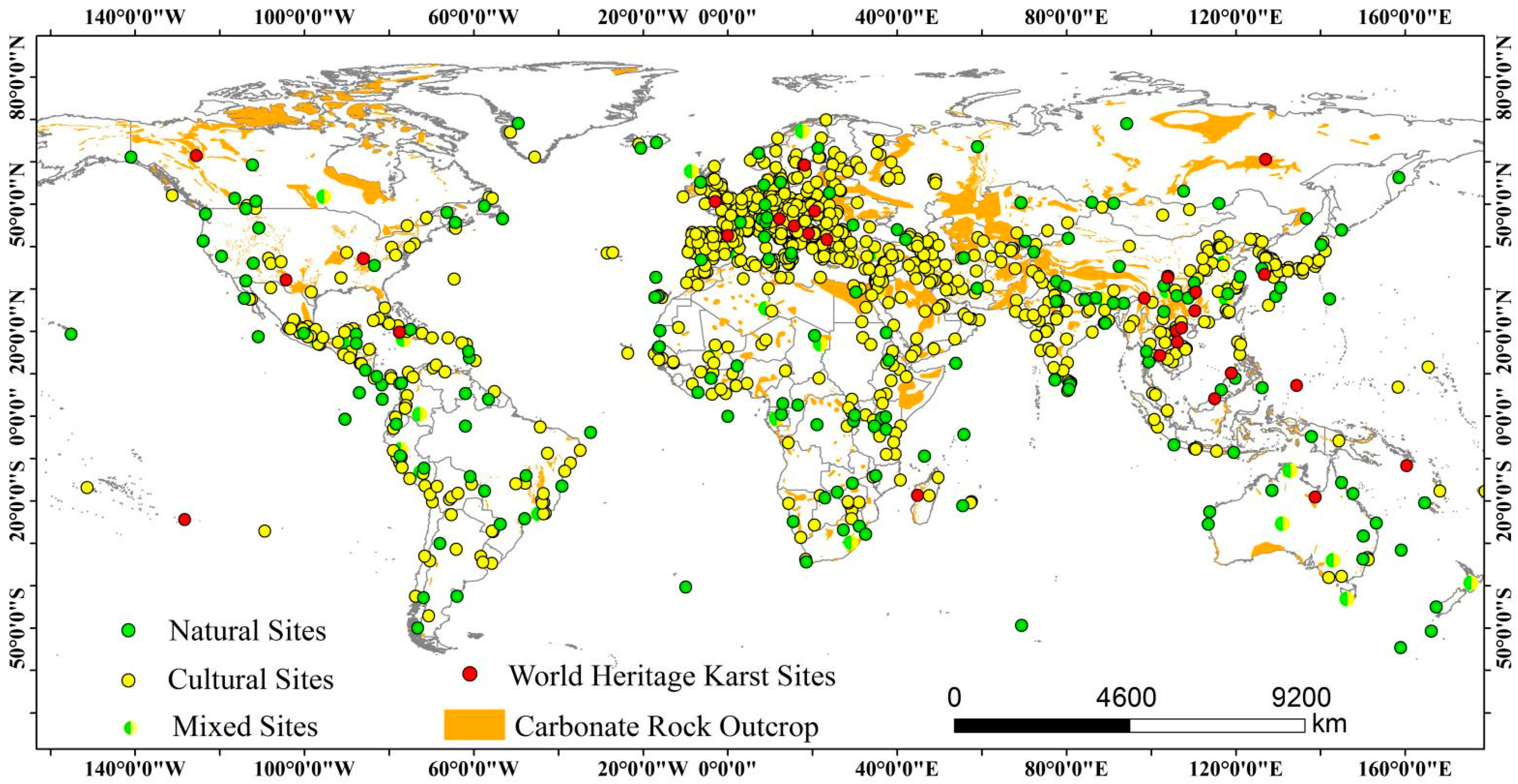
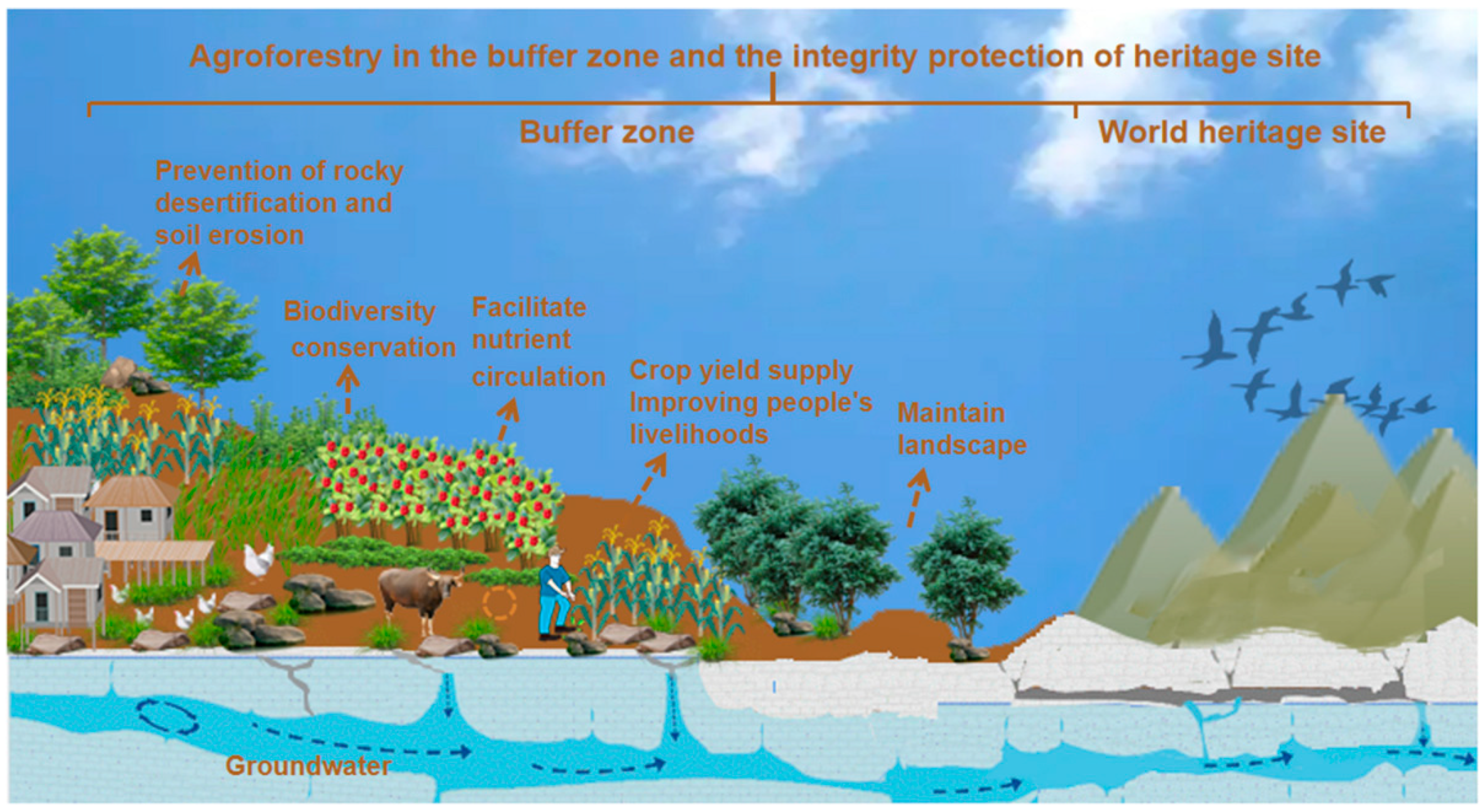
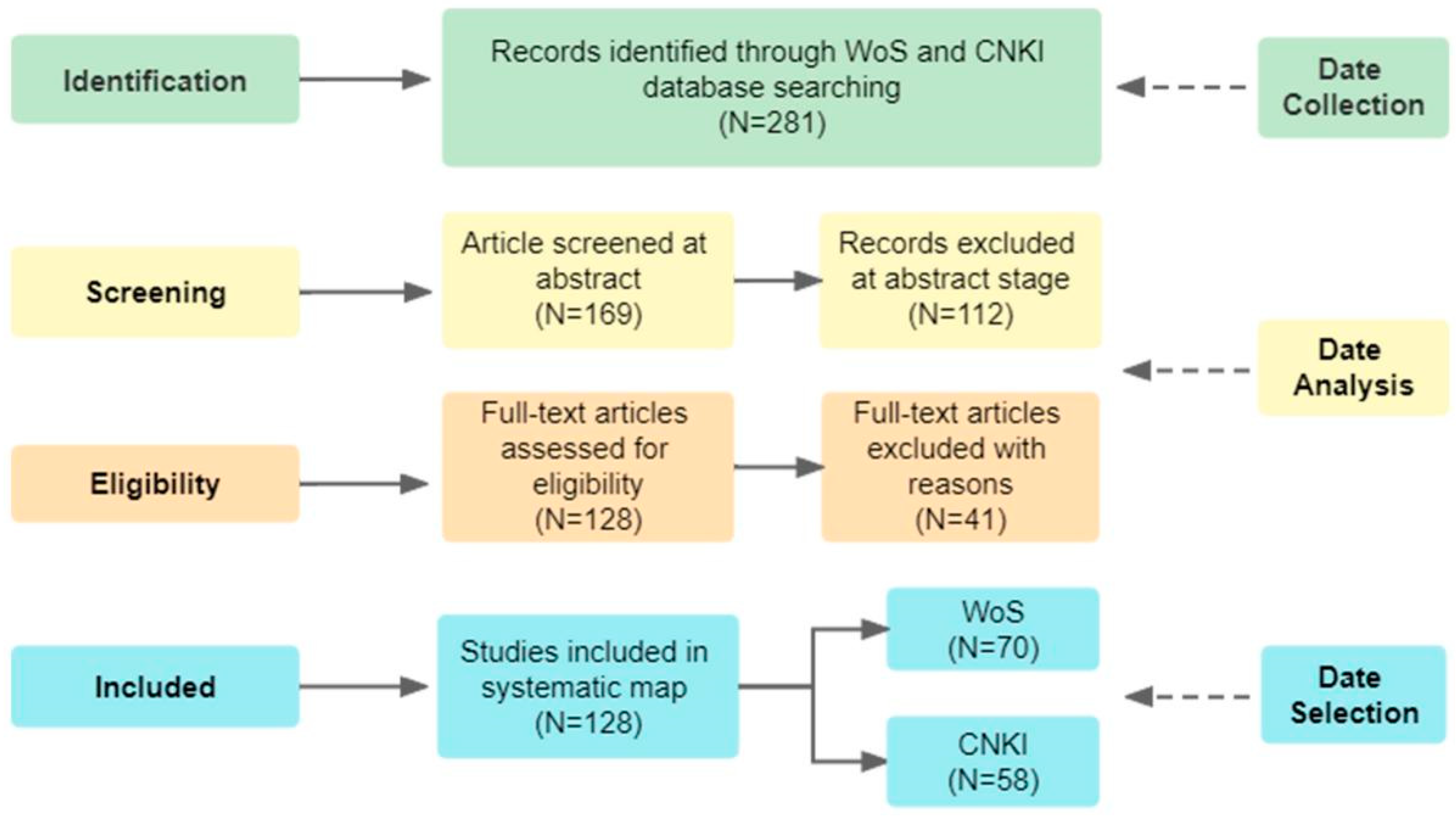
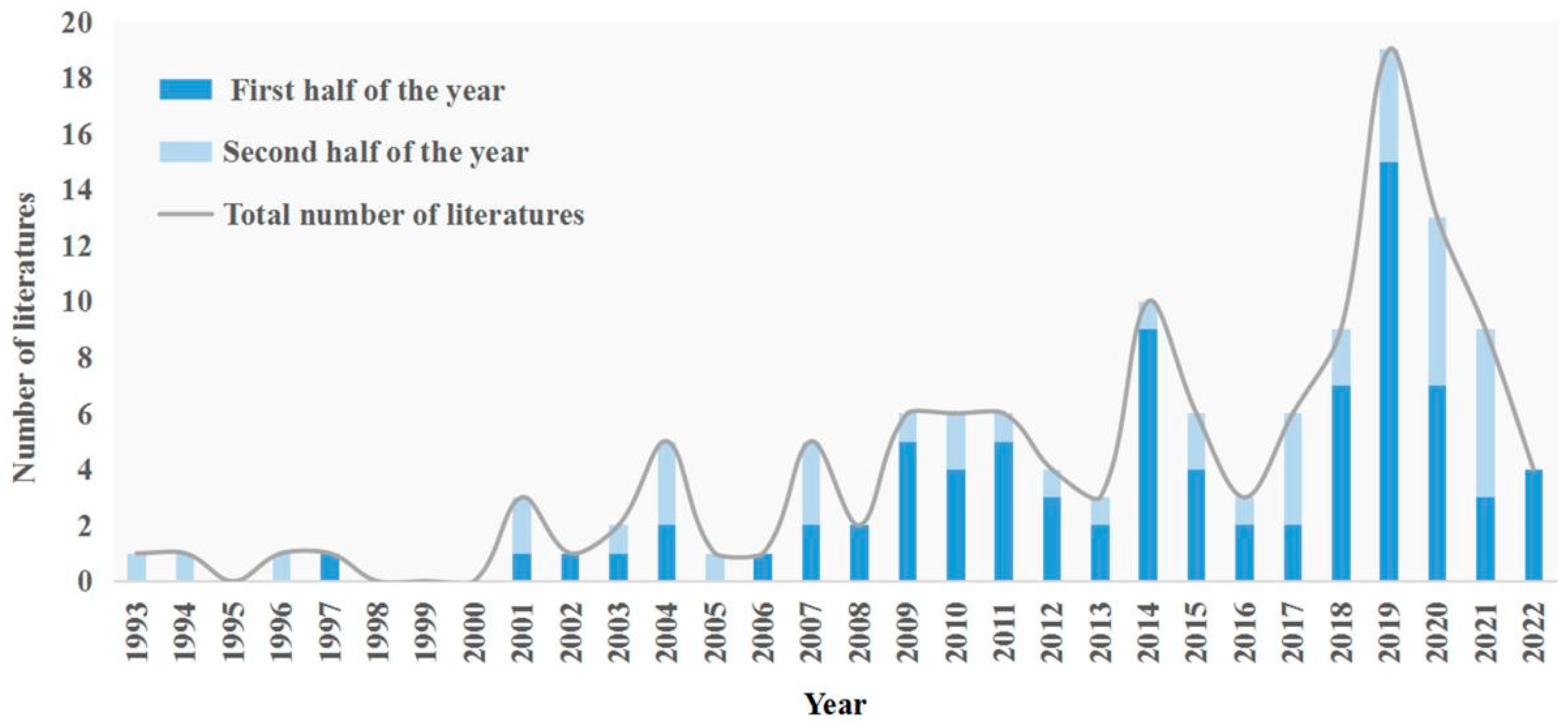
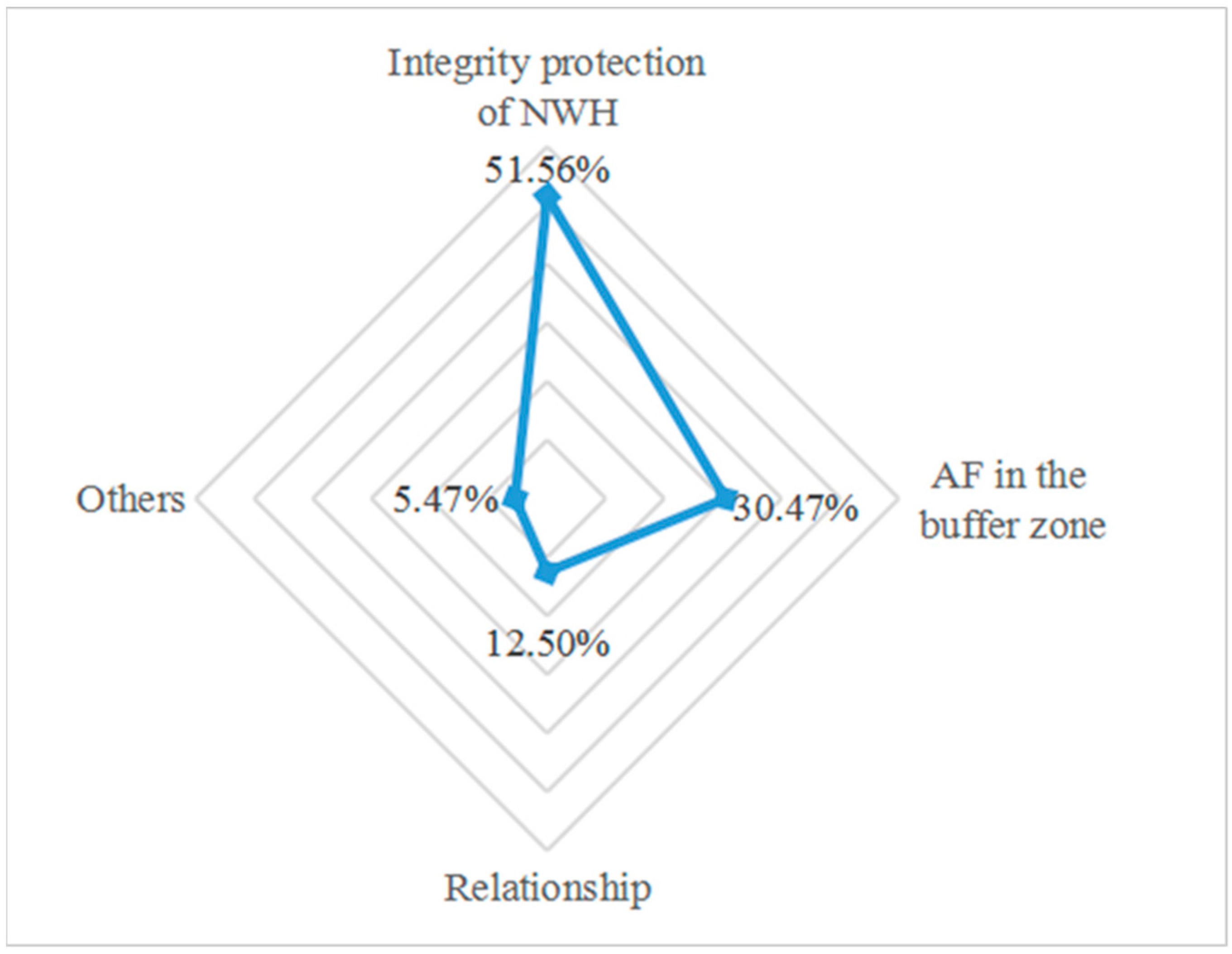
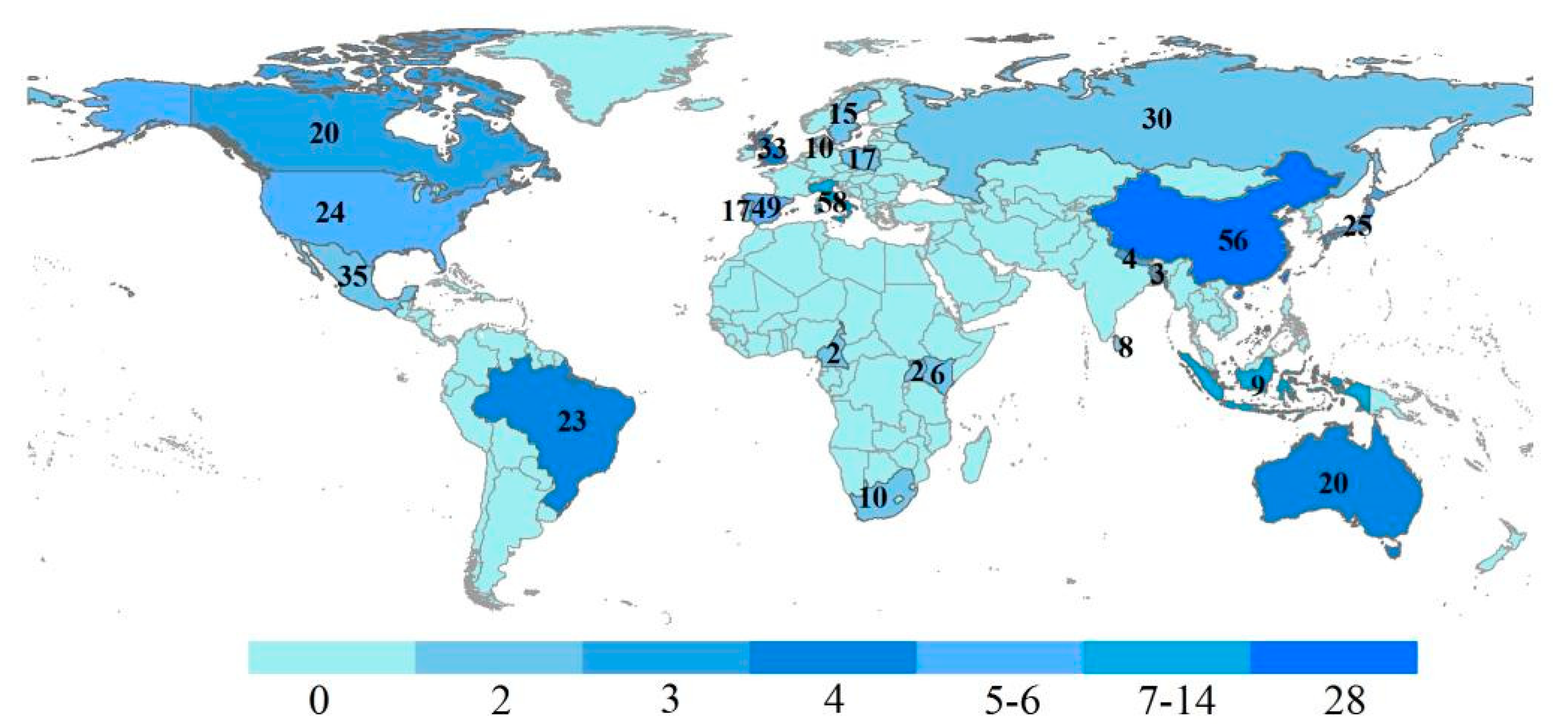

| Database | Retrieval String | Number | Search Date |
|---|---|---|---|
| Wos | First search string: “natural world heritage” | 66 | 30 June 2022 |
| second search string: “integrity protection” | |||
| First search string: “buffer zone” | 99 | 30 June 2022 | |
| Second search string: “agroforestry” | |||
| First search string: “natural heritage” | 14 | 30 June 2022 | |
| Second search string: “agroforestry” | |||
| CNKI | “the integrity of natural heritage” | 100 | 30 June 2022 |
| “agroforestry in the buffer zone” | 1 | 30 June 2022 | |
| First search string: “natural heritage” | 1 | 30 June 2022 | |
| Second search string: “agroforestry” | |||
| Total | 281 | 30 June 2022 |
| Year | Integrity Concept Changes |
|---|---|
| 1977 | The concept of integrity first appeared, and the perception of the concept was limited to the ecological soundness of the system, focusing on the constituent elements of heritage in the physical space |
| 1980 | Increased integrity conditions for migratory species requiring habitat protection throughout their life cycle |
| 1983 | An addition to the integrity requirement: in the case of migratory species, seasonal lots are necessary for the survival of the species and the lot should be given adequate protection regardless of where the species is located |
| 1988 | Added an article to the original; the nominated site should contain adequate long-term legislative, regulatory and institutional protections, further focusing on whether the physical element is in good condition |
| 1994 | The concept of integrity was initially developed, adding to previous ones the importance of management planning, local legislation, local conservation management bodies and nominated site boundaries, while more specific requirements for the protection of biodiversity in heritage sites were introduced in response to the new global convention on biodiversity |
| 1996 | Emphasize that natural aesthetics criteria should not be declared as separate criteria (except in special cases) |
| 1997 | Emphasize that the (iv) criterion must include the habitat conditions necessary for the survival of the species |
| 1998 | The completeness condition is explicitly proposed to be applied to each criterion |
| 1999 | Establishes the importance of local traditional protection methods for integrity |
| 2005 | The concept of integrity includes two elements: wholeness and intactness, and examples of the application of the integrity condition to declared properties based on criteria (i) to (vi) are being developed. |
| 2008–2021 | All properties nominated under criteria (vii)–(x), bio-physical processes and landform features should be relatively intact, and each criterion has a corresponding condition of completeness |
Publisher’s Note: MDPI stays neutral with regard to jurisdictional claims in published maps and institutional affiliations. |
© 2022 by the authors. Licensee MDPI, Basel, Switzerland. This article is an open access article distributed under the terms and conditions of the Creative Commons Attribution (CC BY) license (https://creativecommons.org/licenses/by/4.0/).
Share and Cite
Chen, D.; Xiong, K.; Zhang, J. Progress on the Integrity Protection in the Natural World Heritage Site and Agroforestry Development in the Buffer Zone: An Implications for the World Heritage Karst. Int. J. Environ. Res. Public Health 2022, 19, 16876. https://doi.org/10.3390/ijerph192416876
Chen D, Xiong K, Zhang J. Progress on the Integrity Protection in the Natural World Heritage Site and Agroforestry Development in the Buffer Zone: An Implications for the World Heritage Karst. International Journal of Environmental Research and Public Health. 2022; 19(24):16876. https://doi.org/10.3390/ijerph192416876
Chicago/Turabian StyleChen, Dong, Kangning Xiong, and Juan Zhang. 2022. "Progress on the Integrity Protection in the Natural World Heritage Site and Agroforestry Development in the Buffer Zone: An Implications for the World Heritage Karst" International Journal of Environmental Research and Public Health 19, no. 24: 16876. https://doi.org/10.3390/ijerph192416876
APA StyleChen, D., Xiong, K., & Zhang, J. (2022). Progress on the Integrity Protection in the Natural World Heritage Site and Agroforestry Development in the Buffer Zone: An Implications for the World Heritage Karst. International Journal of Environmental Research and Public Health, 19(24), 16876. https://doi.org/10.3390/ijerph192416876






